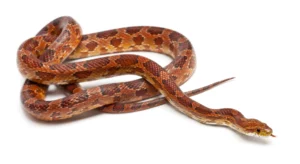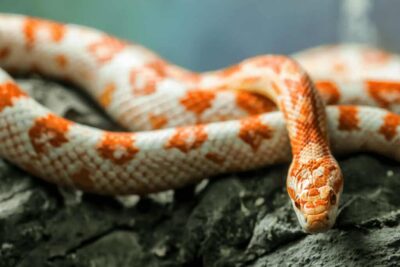For reptile enthusiasts and aspiring pet owners, the allure of corn snakes as captivating companions is undeniable. With their vibrant colors, docile nature, and manageable size, these non-venomous serpents have become increasingly popular in the world of exotic pets.
However, before embarking on the journey of bringing a corn snake into your home, one crucial aspect to consider is the financial commitment involved. In this exploration, we delve into the question on the minds of many potential snake enthusiasts: “How much are corn snakes?”
Unraveling the various factors that contribute to their cost, we aim to provide prospective owners with a comprehensive understanding of the financial aspects associated with caring for these captivating reptiles.
How much are corn snakes?

The price of corn snakes can vary depending on various factors such as the snake’s age, color morph, and breeder reputation. Corn snakes typically range in price from $20 to $100 or more. However, certain morphs or rare color variations can be more expensive.
It’s important to note that prices may change over time, and different breeders may have different pricing structures. If you’re interested in purchasing a corn snake, it’s a good idea to check with reputable reptile breeders, pet stores, or online marketplaces to get current pricing information. Additionally, prices may vary based on your location and the availability of specific morphs in your area.
Factors Affecting Corn Snake Prices
The price of corn snakes can be influenced by several factors. Here are some key factors that can affect the pricing of corn snakes:
- Morph or Color Variation: Corn snakes come in various color morphs, patterns, and combinations. Some morphs are more rare or visually striking than others, leading to higher prices. Popular morphs, such as albino, snow, and caramel, may be more expensive than standard morphs.
- Age and Size: The age and size of a corn snake can impact its price. Younger snakes are generally less expensive than adults, and larger specimens may also command higher prices.
- Genetics and Breeding Line: The lineage and genetics of a corn snake can influence its price. Snakes with desirable genetic traits, strong bloodlines, and reputable breeding can be more expensive.
- Market Demand: Like any commodity, the basic economic principle of supply and demand affects corn snake prices. If a particular morph or trait is in high demand, prices may rise.
- Breeder Reputation: Reputable breeders who have a history of producing healthy, well-cared-for snakes may charge higher prices for their animals. The reputation of the breeder can be an important factor for buyers who prioritize the health and genetic integrity of their future pet.
- Geographic Location: Prices can vary based on geographic location and the availability of certain morphs in different regions. Transportation costs and local demand can influence the final price.
- Health and Genetics Guarantees: Some breeders offer health and genetics guarantees with their snakes. The inclusion of these guarantees, such as assurance against certain health issues or a guarantee of genetic purity, may impact the overall price.
- Market Trends: The reptile market, like any other, can experience trends where certain morphs become more popular or fall out of favor. These trends can affect the prices of corn snakes over time.
If you’re considering purchasing a corn snake, it’s advisable to research the specific morph or traits you’re interested in and find a reputable breeder who can provide information about the snake’s genetics, lineage, and overall health. Always prioritize the well-being of the snake over price considerations.
Price range for common morphs and standard corn snakes
The price range for common morphs and standard corn snakes can vary depending on several factors, including:
Morph:
- Normal: The most common and readily available corn snake morph, typically costing between $25 and $50. They have a reddish-orange base color with brown blotches and a yellow belly.
- Okeetee:Another popular morph, known for its bright orange and yellow coloration with black saddles. Okeetees typically cost around $30 to $75.
- Bloodred:These snakes have a deep red base color with black markings and a cream-colored belly. Bloodred corn snakes can range in price from $40 to $100.
- Amelanistic:Often called “albino” corn snakes, amelanistics lack dark pigments, resulting in a light orange or yellow base color with a white belly. They can cost anywhere from $50 to $200.
Age and sex:
- Baby corn snakes are generally less expensive than adults.
- Female corn snakes are often slightly more expensive than males due to their ability to breed.
Breeder and reputation:
- Snakes from reputable breeders with good genetics may cost slightly more than those from unknown sources.
Overall, here’s a general price range for common morphs and standard corn snakes:
- Normal: $25 – $50
- Okeetee: $30 – $75
- Bloodred: $40 – $100
- Amelanistic: $50 – $200
Remember, these are just estimates, and the actual price of a corn snake can vary depending on the specific factors mentioned above. It’s always best to contact breeders directly for current pricing and availability.
No matter which morph you choose, be sure to do your research and ensure you can provide your corn snake with a proper and loving home. They can be wonderful companions for many years!
Additional Costs Beyond Purchase Price

When acquiring a pet corn snake, the purchase price is just one component of the overall cost. There are several additional expenses to consider when caring for a snake. Here are some potential additional costs beyond the initial purchase price:
- Enclosure: You’ll need a suitable enclosure for your corn snake. This may include a terrarium or vivarium, substrate (bedding), hides, water bowl, and other furnishings. The size of the enclosure should be appropriate for the snake’s size and activity level.
- Heating and Lighting: Corn snakes require specific temperature and lighting conditions to thrive. This may involve the purchase of heating elements such as heat mats or heat lamps, as well as thermostats to regulate temperature.
- Substrate and Bedding: Corn snakes need a substrate or bedding material in their enclosure. Aspen shavings, cypress mulch, or other suitable substrates are commonly used. The substrate may need to be replaced periodically.
- Feeding Costs: Corn snakes are typically fed a diet of mice or rats. The cost of food will depend on the size and age of the snake, as well as the type and size of prey items.
- Veterinary Care: Routine veterinary care and potential emergency medical expenses should be factored into the budget. This may include health check-ups, parasite treatments, or addressing any health issues that may arise.
- Hygiene and Cleaning Supplies: Cleaning supplies such as disinfectants, brushes, and waste removal tools are essential for maintaining a clean and hygienic enclosure.
- Accessories and Enrichment: Additional accessories and enrichment items, such as climbing branches, decor, or items to provide mental stimulation, can enhance the snake’s environment.
- Utilities: The cost of utilities, such as electricity for heating and lighting, should be considered. While this is a relatively small cost, it adds up over time.
- Education and Resources: Investing in educational materials, books, or online resources to learn about proper care and husbandry is crucial for responsible snake ownership.
It’s important to plan for these ongoing costs and ensure that you have the time, commitment, and financial resources to provide proper care for your corn snake throughout its life.
Also, responsible ownership includes not only meeting the basic needs of the snake but also addressing any unforeseen circumstances or health issues that may arise.
Tips for Finding Affordable Corn Snakes
Finding an affordable corn snake involves careful research and consideration. Here are some tips to help you find an affordable corn snake without compromising on its health and well-being:
- Reputable Breeders: Look for reputable breeders with positive reviews and a history of responsible breeding practices. A good breeder will prioritize the health and genetic integrity of their snakes. While their prices may not be the lowest, the value in terms of the snake’s health and background is often worth the investment.
- Local Reptile Shows and Expos: Attend local reptile shows and expos, where breeders often showcase their snakes. These events may offer the opportunity to compare prices, ask questions directly to breeders, and potentially find discounts or special deals.
- Rescue Organizations: Consider adopting a corn snake from a rescue organization or reptile shelter. Adoption fees are often lower than purchasing from a breeder, and you may provide a home for a snake in need. Ensure that the organization has a good reputation and properly cares for their animals.
- Online Reptile Forums and Classifieds: Explore online reptile forums and classified websites where breeders and enthusiasts may advertise snakes for sale. Be cautious and research the credibility of sellers before making a purchase.
- Local Reptile Groups and Clubs: Join local reptile groups or clubs in your area. Members may offer snakes for sale or be able to direct you to reputable breeders with affordable options.
- Pet Stores: While prices at pet stores can vary, some stores may offer reasonably priced corn snakes. Ensure that the store practices ethical breeding and provides proper care for their animals.
- Package Deals or Specials: Some breeders or sellers may offer package deals or specials, especially if you are purchasing multiple snakes or if they have surplus stock. Inquire about any discounts or promotions that may be available.
- Wait for Sales or Promotions: Keep an eye on websites, social media pages, or newsletters of reputable breeders. Some may have sales or promotions during certain times of the year.
- Consider Younger Snakes: Younger corn snakes are often less expensive than adults. If you’re comfortable caring for a snake at a younger age, it could be a more cost-effective option.
Remember, while finding an affordable corn snake is important, it’s equally crucial to prioritize the health, genetics, and overall well-being of the snake. Avoid making decisions solely based on price, and take the time to research and choose a reputable source for your new pet.
Conclusion
If you are considering corn snake as your pet, then you need to know much about all it cost to acquire one. On this page, we have the answer on how much are corn snakes with additional information on additional cost you need to know.

